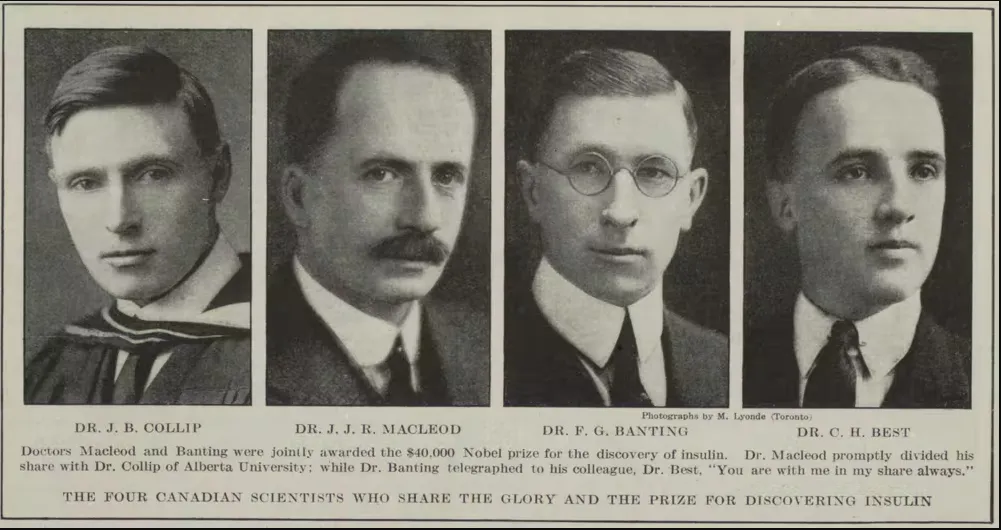Before the discovery of insulin in 1922 and its subsequent commercial release in 1923, type 1 diabetes would have killed you.
It can still happen, but until 94 years ago, it would definitely have passed.
The lives of people with diabetes before 1922 are very gloomy to think about them, but they deserve more than a recognition of their tragedy.I think it is worth exploring what happened, and the way several healers tried to help them.
The old diabetes descriptions are terrible.The Greek doctor of the second century Galen of Pergamo referred to it as "thirsty disease."The Greek word for diabetes, Diabainin, means "siphon", but can be translated as "standing with separate legs", which suggests the (male) posture of urinating.
As you can guess, in ancient times excess urine was the first thing they noticed in patients with diabetes.Capadocia Arete described diabetes as "the melting of meat and urine -shaped limbs."He meant this quite literally.To eliminate all ambiguity, Areteo also said, "life (with diabetes) is short, disgusting and painful."
Areteo was right.Dying CAD (diabetic ketoacidosis) seems to be one of those experiences designed to maximize and prolong suffering.If we imagine a hypothetical person with type 1 diabetes, we know that he could expect to die like this: as his blood began to sweeten, the first symptoms would include extreme thirst, vomiting and, of course, excessive urine.The meat and limbs would begin to "melt."I would lose weight.
Then I would begin to gasp and breathe difficult, which would accelerate fatal dehydration.Anyone who took care of her could smell the sweetness of her breath.In the final stages of diabetic ketoacidosis, it would begin to pass out and perhaps it would begin to vomit what medical literature delicately calls "altered blood."The least disinfected name for this phenomenon is "vomiting in coffee poses."I will save you an explanation;The name is enough.Soon his organs would fail, and the person too.
(I just asked my brother, a medical researcher, to help me summarize this process in simple terms. He suggested: "Your blood becomes poison and die").
Although diabetes was considered rare in the premodern world, it was deadly enough to be remarkable, and many doctors wanted to know how to treat it.According to the Ebers papyrus (discovered in 1872), Ancient Egypt had several ideas about how to treat the mysterious sweet urine disease.
The papyrus tells us that the Egyptian remedies included: "A meter vessel full of water from the bird pond, sauco berry, asit plant fibers, fresh milk, beer drinks, cucumber flower and green dates."This prescription leaves one wondering what kind of birds lived the pond, and why their water would make something in the human body feel better.
The rest of the ingredients (with the exception of "beer drinks") sound vaguely delicious, but their carbohydrates would only worsen things for the patient with diabetes.(This would not be the last time doctors would make a mistake like this: a 17th -century Frenchman called Pierre Priorry reasoned that people with diabetes had to replace the sugar they lost in the urine eating large amounts of sweets. We can only imagine how it wasthis.).
In a more useful way, the famous Greek doctor Hippocrates of the 5th century (yes, of the oath) discovered that a diet low in starch and vigorous exercise could extend the lives of patients with diabetes.He was also one of the first to suggest that there were two or more types of diabetes.
But he remembers Areteo, who said that diabetic life was “short, disgusting andpainful ”.He was a student of Hippocrates, so we can infer that despite the discovery of Hippocrates, the prognosis for people with type 1 diabetes in ancient Greece was still quite bleak.
Avicenna, the Persian Polymate of the eleventh century, was among the first to succeed in the treatment of diabetes for medical purposes.In its encyclopedia 1025 The Canon of Medicine (The Canon of Medicine), prescribed people with diabetes a herbaceous mixture of Altramuz (a legemus with edible peas and Floripondio tips), Fenogreco (a small herb with spicy yellow seeds) andZedoaria (a wetland crop whose roots know Jengibre with a bitter aftertaste).
Together, these herbs did more than an aesthetically formidable bouquet: they worked!At least a little.People with diabetes who consumed this mixture excreted less sugar and their symptoms became less serious.The most useful ingredient is likely;Recent studies have suggested (but not tested) that their yellow seeds can stimulate insulin production, both if you have type 1 diabetes and type 2. In any case, Avicanna could buy a little time from their patients.
Apollinaire Bouchardat (1806-1886), remarkable for more than his name, was perhaps the first doctor in the era prior to insulin in achieving real success in the treatment of type 1 diabetes. During the Franco-Prussian war, he noticedThat when the rations became desperately low, hungry soldiers produced very little glucose in the urine.He applied this observation to his patients with diabetes.It turned out that a hunger diet could prolong people's lives with diabetes (if they could resist, you know, hunger).
Exercise, herbs and hunger: these thing could barely delay the threshold of the death of the person with diabetes.The entire structure of medical history had nothing more to offer until 1922. Each diagnosis meant that a person would melt.
Every time you spill insulin droplets and smell its smell of sour alcohol, remember that it is not fenogreco, that you can eat (almost) what you want, and that you are going to survive.
Although they could not fix the diabetes, they thank Avicenna, to Hippocrates, to all.
Take fresh milk, eat green dates.You are lucky to be here.
Source: Link


